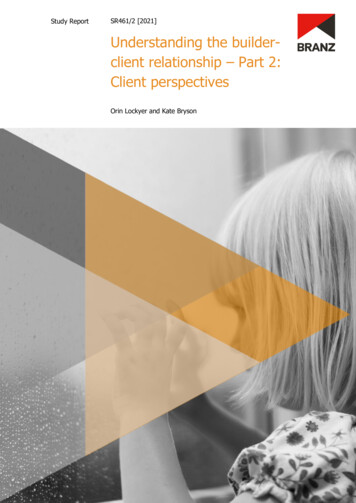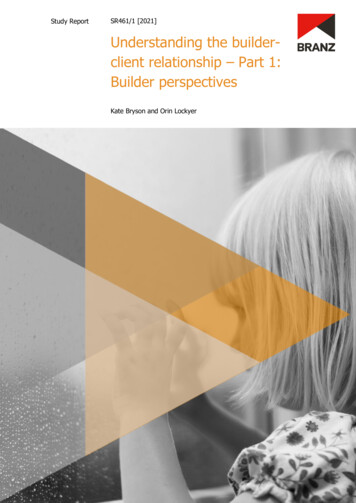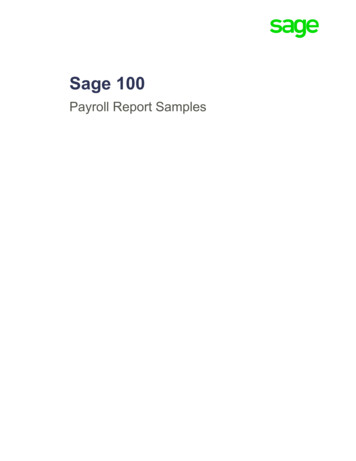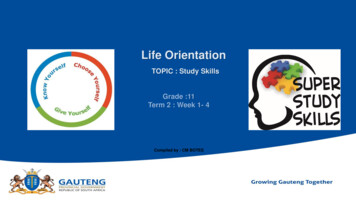
Transcription
Study ReportSR461/2 [2021]Understanding the builderclient relationship – Part 2:Client perspectivesOrin Lockyer and Kate Bryson
1222 Moonshine Rd, RD1, Porirua 5381Private Bag 50 908, Porirua 5240New Zealandbranz.nz BRANZ 2021ISSN: 1179-6197
Study Report SR461/2 Understanding the builder-client relationship – Part 2: Client perspectivesPrefaceThis research was undertaken by Axon Consulting Limited in collaboration with BRANZ.This report is part 2 of a two-part research project that takes an in-depth look at bothsides of the builder-client relationship in an effort to understand what is and what isnot working for each party.AcknowledgementsWe would like to thank: our research partners Registered Master Builders Association (RMBA), New ZealandCertified Builders (NZCB), CHASNZ, and Switched On Group – we particularlyacknowledge the support of RMBA and NZCB who assisted us immensely withrecruitment of their members to participate in this researchthe residential builders who took the time to complete the surveythe residential builders and clients who volunteered to be interviewed and sharedtheir stories with us so that we could better understand the builder-clientrelationship.i
Study Report SR461/2 Understanding the builder-client relationship – Part 2: Client perspectivesUnderstanding the builder-clientrelationship – Part 2: ClientperspectivesBRANZ Study Report SR461/2AuthorsOrin Lockyer and Kate BrysonReferenceLockyer, O. & Bryson, K. (2021). Understanding the builder-client relationship – Part 2:Client perspectives. BRANZ Study Report SR461/2. Judgeford, New Zealand: BRANZLtd.AbstractAnecdotally, the builder-client relationship has been a source of tension and stress forbuilders and clients. This research set out to investigate whether there was anyevidence to support these anecdotes and, if so, what impact it was having on thewellbeing of each party. This report describes the results of an online survey andinterviews with clients to understand the client perspective of the relationship and itsimpact on client mental health. Clients reported several tension points that causerelationship strain with builders and that disagreements with builders stemmed frompoorly managed client expectations. Recommendations are made that focus onimproving communication and managing client expectations to avoid client conflictduring the build process.KeywordsResidential builder, build client, communication, relationship, conflict, mental health,wellbeing.ii
Study Report SR461/2 Understanding the builder-client relationship – Part 2: Client perspectivesContentsEXECUTIVE SUMMARY. 11.INTRODUCTION . 4Purpose .42.METHODOLOGY . 5Scope .5Definitions .5Approach .52.3.1 Survey .52.3.2 Interviews .73.RESULTS. 9Demographics and build details .9Communication with builders – when and how . 12Working with builders – managing expectations, trust and power . 20Disagreements with builders and their impact . 29Mental health impacts of the builder-client relationship . 39Conclusion . 424.DISCUSSION AND RECOMMENDATIONS. 43Communication demands . 43Tension points . 44Defects. 45The impact of disagreements . 45Recommendations . 46Building Together resource . 47Limitations of the research . 47Summary of recommendations . 48REFERENCES . 49APPENDIX A: CLIENT SURVEY. 50APPENDIX B: CLIENT INTERVIEW SCHEDULE. eFigureFigureFigureFigureFigure1. Age of participants. .92. Gender of participants. .93. Regions where participants built. . 104. Expectations of the final product. 105. How long the home took to build. . 116. Expectations of final cost. . 117. Primary liaison person during build. . 128. Frequency of communication with builder. . 129. I should be able to get hold of my builder any time. . 1310. Types of communication used during the build. . 1411. Clients’ preferred method of communication. . 1412. Clients’ satisfaction with communication received from their builder. . 15iii
Study Report SR461/2 Understanding the builder-client relationship – Part 2: Client perspectivesFigure 13. I would rather my builder took the time to communicate with me if it meansthe build process takes longer. . 16Figure 14. Catching up with my builder to hear how the build was going was one of myfavourite parts of the project. 16Figure 15. I did not need to know what was going on on site, as long as the builderwas getting the job done . 17Figure 16. I would sometimes get frustrated at how little information the builder gaveme about what was happening on site. . 18Figure 17. Frequency of clients being on site. . 18Figure 18. I knew what to expect from my builder during the build process becausethey explained everything from the start. . 21Figure 19. How would you rate your builder in organising subtrades and keeping to theagreed-upon scheduling updates about the build? . 23Figure 20. There were times I had to be very assertive with my builder to get my pointacross. . 24Figure 21. I researched the building process to make sure my builder was doing theirjob properly. . 25Figure 22. These days it is up to the client to make sure that the builder is doing theirjob properly. . 25Figure 23. I found it difficult to trust my builder. . 27Figure 24. Builders hold all the power in the builder-client relationship. . 28Figure 25. Proportion of clients experiencing issues or disagreements with builders. . 30Figure 26. Number of issues or disagreements experienced by clients. 30Figure 27. What trigged the disagreement? . 31Figure 28. Person who normally identified building defects. . 31Figure 29. Client comfort with detection of defects during the build. . 32Figure 30. We were able to resolve the disagreement with my builder successfully. . 33Figure 31. How disagreements were resolved. . 33Figure 32. Client satisfaction with builder response to fixing issues during the build. . 34Figure 33. Client satisfaction with timing of resolution. . 35Figure 34. Did you have any PC sums and/or variations? . 36Figure 35. Why was the variation to the original plan or budget needed? . 37Figure 36. After the disagreement with my builder, the rest of the build process wasruined for me. . 38Figure 37. Building a home was one of the most stressful things I’ve ever done. . 39Figure 38. During the build process, I had at least one disagreement with my builderthat negatively impacted my mental health. . 40Figure 39. The disagreement with my builder was so distracting it affected my ability toconcentrate on other aspects of my life. 41iv
Study Report SR461/2 Understanding the builder-client relationship – Part 2: Client perspectivesExecutive summaryThis report is part 2 of a two-part study exploring the builder-client relationship.Anecdotal stories from builders and clients have suggested that the builder-clientrelationship could be one cause of significant distress for both parties during residentialhouse builds. This study set out to investigate if there was any evidence to supportthese anecdotes and, if so, what impact builder-client relationship tension is having onthe wellbeing of each party. This research examined both sides of the relationship, butthis report describes the client’s perspective. The findings relating to builders arereported in BRANZ Study Report SR461/1 (Bryson & Lockyer, 2021).Research questions Is the builder-client relationship a significant cause of stress for residential clients?If so, what factors are contributing to the builder-client relationship problems andhow prevalent are they?MethodsThis research used a mixed-methods approach – 112 clients responded to an onlinesurvey, and 30 took part in semi-structured telephone interviews. A combination ofquantitative and qualitative data is used to measure the prevalence and describe thetension points that lead to builder-client conflict.ResultsThe results of this research fall into three key areas: Communication between clients and builders.Tension points during the build process.The impact of disagreements on client wellbeing.The overarching theme throughout the findings is communication. Conflict anddisagreements very often emerged when the client’s expectations were not met.Communication with the builder Clients require regular contact with both the site and their builder. Positivecommunication experiences hinged on builders setting client expectations earlywhile being receptive to their client’s desire for more information as the buildprogressed.Access to site and the information clients gather from the site was a major point ofcontention. Clients are pushing hard to have access to the site (supervised orunsupervised). When unsupervised visits occur, builders are unable to providecontext to unsupervised clients and help them understand ongoing site processes.Current communication practices between builders and clients are not necessarilyconducive to a more active and involved client on site.Tension pointsSeveral tension points were identified as potential causes of disagreements betweenbuilders and clients. Tension points lead to conflict when the client’s expectationsaround them are not met or were mismanaged:1
Study Report SR461/2 Understanding the builder-client relationship – Part 2: Client perspectives 51% of our sample said they had a disagreement with their builder. Of that group,44% said they had 1–3 disagreements with their builder over the course of thebuild, 26.5% had 4–6 and 20% had 10 or more.Clients’ experienced tensions caused by workmanship issues, variations, timeframesand contracts. However, there was no data to suggest that any specific type oftension point was perceived worse than any other.The cause of tension for clients was when they identified issues that were notacknowledged and actively resolved by their builder.Our study showed that disagreements were normally rectified by the client’sbuilder, but that is always contingent on the builder agreeing that the client’sidentified disagreement or defect is valid.If a builder is not willing to acknowledge what a client has identified as a tensionpoint or has no incentive to resolve any tension points, this becomes a majorsource of dissatisfaction on the part of the client.The impact of disagreements on builder mental wellbeing There was a wide variance amongst clients compared to builders when asked aboutthe impact disagreements had on their mental health – 55.1% mentioned they hadeither a small or moderate impact to their mental health, while a further 20.4% feltthat their disagreements with builders had a major impact on their mental health.The severity of impact on mental health depended on whether the disagreement inquestion had been resolved to the client’s satisfaction. Those clients who had theirdisagreement resolved promptly were better off compared to those who were stillwaiting for a resolution.RecommendationsClients need more education around what it means to be a newbuild client. Clients inour sample are torn between being a ‘good customer’ who tries not to act pushy andbeing an assertive client who pushes to ensure their specifications have been fulfilledbefore handover. Clients need their rights and responsibilities clearly outlined beforethe build process begins, and this should be part of initial expectation-setting meetingsbetween builders and clients.This report echoes much of the recommendations of the builder perspectives report.Managing the relationship with the builderThe Building Together resource should be developed – a proposed workbook thatwould guide builders and clients through an early conversation about how they willwork together throughout the building process. It is suggested it could provide spaceto record what has been agreed between the builder and client and should function asa mutually agreed code of conduct.The development of the Building Together resource should be done in consultationwith residential builders and clients. This should be done via facilitated workshops orfocus groups where these research findings are presented to builders and clients toprovide further input on the format, structure and content of the resource.As a starting point, the areas covered in this resource should include: when and how a builder can be contactedthe frequency and duration of site visitssupervision during site visits2
Study Report SR461/2 Understanding the builder-client relationship – Part 2: Client perspectives health and safety requirements at site visitsinteractions with subcontractors or other tradespeople on sitedefect identification processesother tension points identified by clients in this report.Supporting client mental health and wellbeingExisting mental health help options within and outside the industry should continue tobe promoted and supported.Residential building leadership organisations should prioritise the development ofmental health and wellbeing programmes that work well in a residential buildingcontext.Supporting clients at crucial decision-making pointsA separate resource should be developed that provides newbuild clients with advice onhow they can better match their expectations with an appropriate builder. It should: include a decision tree that maps out all the decision-making points where clientsinteract during the build processwalk clients through their expectations and the type of questions they may need toask to ensure their expectations are met before beginning the formal process witha builder.The resource should be developed in partnership between consumers and industry forbest results.3
Study Report SR461/2 Understanding the builder-client relationship – Part 2: Client perspectives1.IntroductionPurposeDuring the construction of a residential building, the communication between builderand client can be a difficult process. Previous research at BRANZ has investigated clientexperiences of building a new home. Recent research has highlighted the difficulty thatclients had when communicating with their builder, which can lead to a breakdown incommunication (Lockyer & Marston, 2020). These were based on several complexfactors such as a lack of information around the current progress of the build, clientidentified defects not being acknowledged by their builder, negotiating access to thesite and an unclear understanding of their own rights and responsibilities as a client.This report seeks to enhance previous research by examining the builder-clientcommunication in more depth and identify the key tension points in this industrypractice.To understand the impact on build quality and wellbeing, it’s important to understandhow the practice of communication between builders and clients leads to poor qualityand wellbeing outcomes. To the best of our knowledge, no previous research has beendone to investigate the interpersonal aspects of the builder-client relationship or itsimpact on the wellbeing of either party. More specifically, this study aims to assesshow we can improve communication channels between clients and builders. Theresults of this research will be used to make recommendations and inform solutions, ifany are required.At the same time, the mental health and wellbeing of construction industry workershas been in the spotlight in recent years after the publication of Bryson and Duncan’s(2018) report on mental health in the construction industry. In that study,representatives from across the industry acknowledged that the mental health of theworkforce was in desperate need of support. Since then, the industry has beenmobilised into action with many organisations and businesses working to increaseawareness around mental health and the MATES in Construction suicide preventionprogramme launching in 2019.The builder perspective of the builder-client relationship was also investigated as partof this research, and findings are presented in a separate report (Bryson & Lockyer,2021). Together, these reports look to provide a detailed explanation of the builderclient relationship from both perspectives. The goal of this research is to describe andunderstand both sides of the builder-client relationship. By understanding both thebuilder and the client’s perspectives, it will enable ways for government and industry toidentify ways of supporting builders and clients to work together in a way that supportsmutual interest and nurtures health and wellbeing within industry to enable betterbuilding outcomes.Research questions: Is the builder-client relationship a significant cause of stress for residential clients?If so, what factors are contributing to the builder-client relationship problems andhow prevalent are they?4
Study Report SR461/2 Understanding the builder-client relationship – Part 2: Client perspectives2.MethodologyScopeThis study investigates the relationship between residential builders in New Zealandand their clients. A mixed methods approach was chosen because of its flexibility,alongside the need to understand both the prevalence and context of communicationpractice. The study used quantitative online surveys and qualitative interviews of bothbuilders and clients to understand the prevalence and impact of builder-clientdisagreements on builder mental health and client satisfaction. The methods describedhere were undertaken for both builders and clients. This report describes the results ofthe client survey and interviews.The commercial building sector was not included in this study as their clients andprocurement and project management processes are different to those of theresidential builder. This study focuses on the interpersonal relationship betweenindividual builders and their clients.DefinitionsFor the purposes of this research, we use the term ‘builder’ to describe the personacting on behalf of the company that constructed the home for the client. In mostcases, this is the person building the house, but in some cases, it will be a projectmanager or sales representative. A detailed breakdown of the roles represented by theterm ‘builder’ is provided in the results section.The term ‘client’ is used to describe anyone who responded to the survey or wasinterviewed about having their home built for them by a residential builder.The ‘builder-client relationship’ is the term used to describe the way builders andclients worked together as people. There is a distinction here between the legal orcontractual relationship each party had entered into and the way they interacted witheach other throughout the building process. The builder-client relationship referred toin this report means the interpersonal relationship between the individuals involved inthe build.ApproachThis study utilised a mixed-methods approach. Online surveys were used to gatherquantitative data from builders and clients about their experiences dealing with eachother.At the end of the survey, participants were invited to be interviewed about theirexperience, and qualitative data was collected to give the quantitative findings greatercontext.2.3.1SurveyTwo surveys were conducted – one for builders and one for clients. Each was designedto gather quantitative data to measure the extent of builder-client relationship tension,to identify possible causes of the conflict and to understand how this conflict impactedthe mental wellbeing of each party.5
Study Report SR461/2 Understanding the builder-client relationship – Part 2: Client perspectivesIn total, 216 builders and 112 clients responded to the surveys. The surveys were runin February and early March 2020. The data collection period for the survey was cutshort due to the COVID-19 Alert Level 4 and 3 lockdown. The research team decidedthat it was inappropriate to continue with recruitment given the impact the pandemicresponse was having on the industry. Additionally, reactions to the lockdown may haveskewed responding to the survey and impacted our results. The shortened datacollection phase did impact sample size. However, enough data had been gathered toallow for meaningful analysis. Confidence in the quantitative data is furtherstrengthened by the addition of the qualitative findings. The combination of these twodata sources ensures the results of this study are reliable despite the smaller thanexpected sample.The client survey somewhat mirrored the builder survey. The goal of the client surveywas to measure the prevalence of builder-client relationship issues from the client’sperspective.The client survey consisted of several sections. All the questions in the client surveyare presented in Appendix A.The first section gathered demographic information and details of their house build.We asked clients about: their agetheir genderwhat region their new home is inthe cost of their buildwhether their home met their budget expectationswhether their home met their expectations.The second section gathered data about the build process and communication withtheir builder. We asked clients about: who they dealt with during the buildfrequency and methods of communication with their buildersatisfaction with the amount of communication with their builderpreferred method of communication with their builder.The third section collected data about clients’ experiences during the build and theiropinions about the build process. In the same way as the builder survey, a series ofstatements were presented to clients that they were asked to agree or disagree withusing the options ‘strongly disagree’, ‘disagree’, ‘neither agree nor disagree’, ‘agree’ or‘strongly agree’. This section measured the prevalence of builder-client relationshipproblems for the clients during their recent house build experience. Similar to thebuilder survey, we tested whether some of the anecdotal stories we were aware ofwere real phenomena. In the early phases of this research, some builders describedsome client attitudes that they found challenging to deal with. We used the clientsurvey to measure whether these attitudes or beliefs were evident or even common forclients in our sample. Statements about the negative aspects of the builder-clientrelationship were balanced out with statements about the satisfying aspects. Examplestatements from this section of the survey: I had a great relationship with my builderI lost sleep at night over issues with my builder6
Study Report SR461/2 Understanding the builder-client relationship – Part 2: Client perspectives Catching up with my builder to hear how the build was going was one of myfavourite parts of the processMy builder didn’t seem to understand what a big deal building a house was for meWorking with my builder was the best part of the build processThese days it is up to the client to make sure the builder is doing their job properlyIn the fourth section, clients were asked whether they had any notable disagreementswith their builder during their build. Those who said they did were then asked furtherquestions about the disagreement, including the number of disagreements they hadand how much they agreed with a variety of statements measuring the impact of thedisagreements. The same response options were given as those in the previous sectionof the survey. Example statements from this section of the survey: I wished I could change my builder part way through the build due to the stress ofa disagreement with my builderWe were able to resolve the disagreement with my builder successfullyAfter the disagreement with my builder the rest of the build process was ruined formeRecruitmentRecent home build clients were recruited by email from BRANZ’s database.Respondents to that survey were asked if they consented to be contacted again forfuture surveys. Those who indicated their consent received an email inviting them toparticipate in this research. Participation was incentivised by offering to putparticipants in a draw to win a 300 gift card.A link to the online survey was included in the email. Informed consent for surveyparticipation was inferred by completion of the survey. The first page of the surveygave potential participants an overview of the study, what kinds of questions to expectand the ethical considerations around confidentiality and the voluntary nature ofparticipation. Participants were invited to continue on to begin the survey if they werehappy to do so.AnalysisResponses to the survey were downloaded from Qualtrics into Statistics Package forthe Social Sciences (SPSS) software for analysis.The quantitative results presented in this report are descriptive. Graphs describe theproportion of clients in the survey that responded in different ways to each question.The goal of presenting descriptive statistics is to provide a picture of how commonthese experiences are for clients. The qualitative data from the interviews is thenpresented to flesh out each finding with explanations and descriptions of the situationfor clients.2.3.2InterviewsSemi-structured interviews with builders and clients were undertaken to providequalitative data to help explain and provide context for the quantitative findings.Qualitative data is used in this study to assist in understanding why builders and clientsmight have certain perceptions or experiences. As this research is examining two sidesof a potentially challenging relationship, qualitative data helps both sides to understandeach other better.7
Study Report SR461/2 Understanding the builder-client relationship – Part 2: Client perspectivesInterview designThe semi-structured interview schedule for clients can be found in Appendix B. Semistructured interviews are conversational, with the interviewer often taking theinterviewee’s lead on the direction of the interview. For this reason, every interview isdifferent. The interview schedule is a guide to the interviewer around which ideasshould be investigated during the course of the interview. Not every question in theschedule is answered by every interviewee. However, the issues each question isaddressing should be covered in most cases.The client interview asked clients to describe what their relationship with their builderwas like and how that impacted their experie
Lockyer, O. & Bryson, K. (2021). Understanding the builder-client relationship - Part 2: Client perspectives. BRANZ Study Report SR461/2. Judgeford, New Zealand: BRANZ Ltd. Abstract Anecdotally, the builder-client relationship has been a source of tension and stress for builders and clients. This research set out to investigate whether there .










